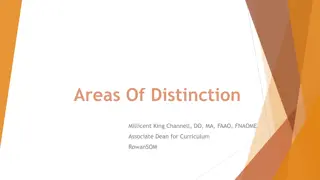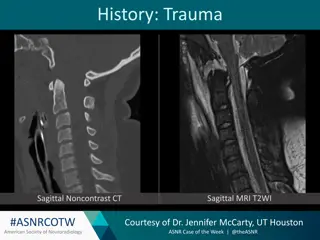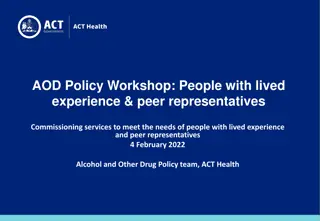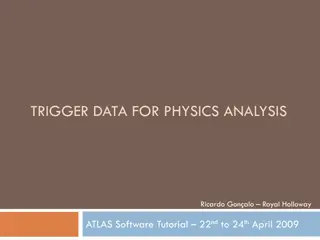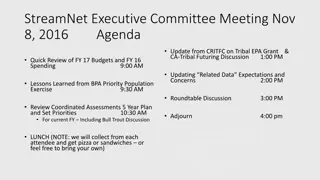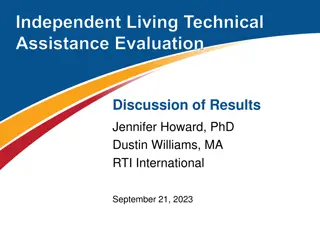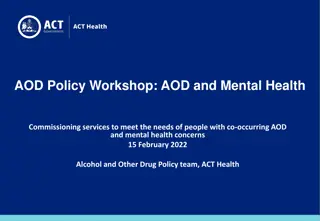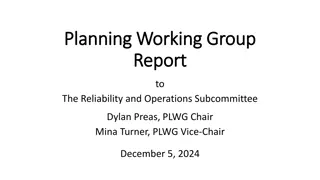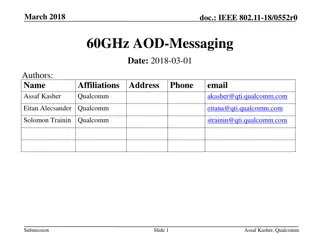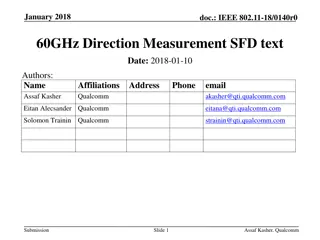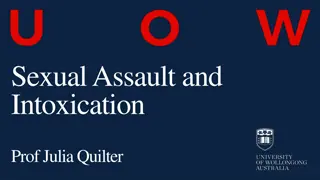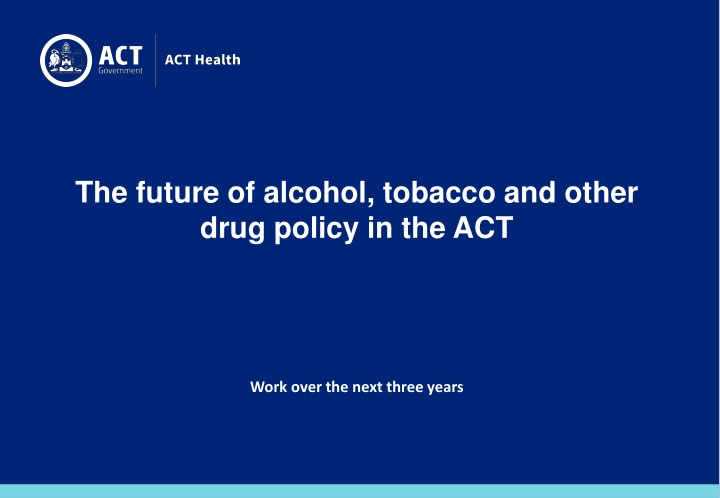
Future of Alcohol, Tobacco, and Drug Policy in the ACT - Insights and Commitments
Reflect on the strengths, opportunities, and commitments outlined for alcohol, tobacco, and drug policy in the Australian Capital Territory over the next three years. Highlights include well-functioning treatment services, opportunities for improvement, and key commitments such as increased funding, pill testing at festivals, and training initiatives.
Download Presentation

Please find below an Image/Link to download the presentation.
The content on the website is provided AS IS for your information and personal use only. It may not be sold, licensed, or shared on other websites without obtaining consent from the author. If you encounter any issues during the download, it is possible that the publisher has removed the file from their server.
You are allowed to download the files provided on this website for personal or commercial use, subject to the condition that they are used lawfully. All files are the property of their respective owners.
The content on the website is provided AS IS for your information and personal use only. It may not be sold, licensed, or shared on other websites without obtaining consent from the author.
E N D
Presentation Transcript
The future of alcohol, tobacco and other drug policy in the ACT Work over the next three years
Purpose of the session Reflect on what we ve heard Highlight what we know and what we need to find out Set out forward work plan for ATOD policy and linkages between different pieces of work 2
What weve heard strengths Well-functioning, engaged treatment and support services Low AOD use relative to other jurisdictions Country-leading initiatives High levels of consumer satisfaction Second highest rate among Australian states and territories for diversion from criminal justice system for minor drug offences ACT s AOD rehabilitation services demonstrate on a daily basis that recovery from addiction is possible. submission to Select Committee Inquiry. 4
What weve heard opportunities Increase access to evidence-informed, effective and affordable treatment and support services, for people who use drugs, their families and carers Workforce sustainability Improve linkages between services, particularly AOD and mental health Access to community housing (e.g. post treatment) Increase proportion of diversions from criminal justice system Reduce harms from alcohol and tobacco targeted responses Further work to prevent and reduce overdoses Strengthen data collection and analysis Infrastructure preservation and capacity Streamlining administration Funding sustainability of services 5
Parliamentary Agreement and Election Commitments Set out a number of clear Alcohol and Other Drug priorities Double the existing funding for services to address drug and mental health co-morbidity Introduce permanent pill testing at all ACT festivals and other sites Pilot a safe drug consumption site Train GPs to better understand the medicinal cannabis scheme Enhance drug diversion pathways for law enforcement Work with Aboriginal Health and Community Services to deliver a culturally appropriate residential alcohol and other drug rehabilitation service for the ACT Aboriginal and Torres Strait Islander community a multidisciplinary service to support young people who have mental health needs co-occurring with trauma, disability or drug and alcohol use 6
Parliamentary and Governing Agreement Parliamentary and Governing Agreement (PAGA), Appendices 1 and 2 = Agreed Government priorities Later PAGA Appendices 3 and 5 = Labor and Greens policy priorities respectively subject to Budget considerations What does this mean? 7
Known Priorities Known priorities for the next two years: New Alcohol, Tobacco and Other Drug Plan Commissioning Aboriginal and Torres Strait Islander Alcohol and Other Drug Residential Rehabilitation and broader Watson Precinct Fixed Site Pill Testing Medically Supervised Injecting Facility Drugs of Dependence Amendment Bill 8
Future ACT Budgets May provide opportunities for further funding for services beyond the existing allocation Now is the time to start thinking about the next budget While budget considerations are confidential, we do want to work together on understanding the needs 10
ALCOHOL AND OTHER DRUG TREATMENT AND DRUG USE Review of ACT Data 11
Tobacco use ACT Smoking Status 2001 (%) 2019 (%) Change (%) Never smoked (14+) 50 69 +19 Never smoked (18- 24) 48 86 +38 Daily smokers (14+) 18 8 -10 Daily smokers (18- 24) 31 10 -21 Ex smokers (60+) 47 31 -16 12
Alcohol consumption ACT Drinking Status 2001 (%) 2019 (%) Change (%) 2 standard drinks per day (14+) 21 17 -4 2 standard drinks per day (25-29) 24 18 -6 2 standard drinks per day (50-59) 22 21 -1 2 standard drinks per day (60+) 15 15 - *Abstainer (14+) 17 24 +7 Abstainer (25-29) 9 24 +15 Abstainer (50-59) 17 17 - Abstainer (60+) 27 24 -3 13
COVID-19 AOD snapshot ACT COVID-19 Trends: Reduced consumption of recreational drug use during lockdowns, particularly for MDMA (ecstasy) and cocaine Increased use of cannabis during 1st lockdown and record use June 2020 Rates of nicotine consumption remained high throughout 2020 *Alcohol consumption trends were mixed (highest in June 2020), although accessibility increased due to on-demand alcohol **Heroin consumption reached a 4-year high August 2020. Perceived purity of ecstasy and cocaine was lower in 2021 than 2020. Perceived purity of heroin was higher in 2021 than 2020. 14
Drug use and harm Use of all illicit drugs has reduced from 2001 to 2019 with the exception of cocaine (2001=1.5%, 2019=3.5%). There has been no significant change in the rate* of ambulance attendances related to drug use from 2015 to 2020. There has been no significant change in the rate of drug induced suicides, unintentional drug induced deaths and total drug induced deaths in the ACT from 2005 to 2019. Illicit drug use contributed to 2.7% of disease burden in 2015 Rates of clients receiving pharmacotherapy treatment has not changed significantly from 2005 to 2020 in the ACT or Australia. 15
AOD treatment services AOD treatment services, closed episodes in the ACT, 2010/11 to 2019/20 35.0 30.0 Proportion of Total services (%) 25.0 20.0 15.0 10.0 5.0 0.0 2010/11 2011/12 2012/13 2013/14 2014/15 2015/16 2016/17 2017/18 2018/19 2019/20 Counselling Withdrawal management Assessment only Support and case management Rehabilitation Pharmacotherapy Information and education Other 16
AOD treatment services AOD treatment services - closed episodes for own drug use in the ACT 2010/11 to 2019/20 60.0 50.0 Proportion of total drug use (%) 40.0 30.0 20.0 10.0 0.0 2010/11 2011/12 2012/13 2013/14 2014/15 2015/16 2016/17 2017/18 2018/19 2019/20 Heroin Other opioids Alcohol Amphetamines Cannabis 17
Client profile (based on a one day snapshot) Context treatment Over the period 2015 16 to 2019 20 in ACT: alcohol remained the most common principal drug of concern in AOD treatment episodes (42%) amphetamines was the second most common principal drug of concern, but decreased from 25% in 2016 17 to 23% in 2019 20 the proportion of closed episodes for cannabis as the principal drug of concern has steadily declined (15% to 11%) 58.3% male 37.5 years mean age 31.0% Aboriginal and/or Torres Strait Islander 20.4% with a disability 49.9% over 18+ with Year 10 or less as their highest level of education 61.2% of adults are parents 69.5% unemployed or not working 30.1% homeless or at risk of homelessness 88.6% living in the ACT (1/5th in Tuggeranong) 75.3% said their drug use had reduced as a result of using the service Most frequently requested type of ancillary service housing (13.8%)
State/ Territory Area Frequency Proportion (%) Frequenc y Proportion (%) Postcode ACT-Belconnen ACT-North Canberra ACT-South Canberra ACT-Gungahlin & Hall ACT-Jerrabomberra & Majura ACT-Tuggeranong ACT-Weston Creek & Molonglo Valley 1113 1049 361 521 72 1090 311 17.3 16.3 5.6 8.1 1.1 16.9 4.8 ACT Table A5.5: Proportion of closed episodes of care for the ACT, NSW and other states/territories (ACT, 2019-20) (Source: ACT AODTS- MDS, 2019-20) 5146 79.9 ACT-Woden Valley ACT-Shared postcodes 2618 and 2620* 419 146 6.5 2.3 64 371 1.0 5.8 ACT-No fixed address NSW-shared postcodes 2618 and 2620* NSW NSW-Illawarra & South East NSW 411 6.4 NSW-Riverina NSW-Central & Northern Sydney 112 47 1.7 0.7 NSW-Southern & South Western Sydney 43 0.7 1090 17.0 NSW-Western NSW NSW-Western Sydney & Blue Mountains 24 18 0.4 0.3 NSW-Hunter & Central Coast NSW-North Coast & Mid North Coast 21 16 0.3 0.2 NSW -New England NSW-No fixed address States and Territories other than NSW, including those with no fixed address 10 17 0.2 0.3 Other states/ territories 80 1.3 80 1.3 Unknown/ Not stated/inadequately described Total 122 6438 1.9 122 6438 1.9 100.0 100.0
Table A5.6: Proportions of episodes of care for service users of ACT AOD services from within and outside the ACT, by treatment setting* (Source: ACT AODTS-MDS, 2019-20) Treatment setting Postcode by treatment setting Non-residential treatment facility, Home, Outreach and Other Location Residential treatment facility Total 87.7 12.3 100.0 ACT Outside ACT (NSW & other states/ territories) 70.2 29.8 100.0 Not stated/ inadequately described/ unknown 92.6 7.4 100.0 84.6 15.4 100.0 Total Table A5.7: Proportions of episodes of care for service users of ACT AOD services accessing various treatment settings, by postcode region* (Source: ACT AODTS-MDS, 2019-20) Treatment setting Non-residential treatment facility, Home, Outreach and Other Location Residential treatment facility Total 82.9 63.8 79.9 ACT Outside ACT (NSW & other states/ territories) 15.1 35.3 18.2 Not stated/ inadequately described/ unknown 2.1 0.9 1.9 100.0 100.0 100.00 Total
NEXT ALCOHOL, TOBACCO AND OTHER DRUG PLAN 21
New Alcohol, Tobacco and Other Drug Plan The National Context 22
Drug Strategy Action Plan (DSAP) Review A policy review, co-drafted with ATODA and DSAP Advisory Group Research Advisor, to inform development of the new ATOD Plan Draft will soon be out for feedback DSAP Review and DSAP final progress report expected by December 2021 23
Thoughts on Governance Model DSAP Advisory Group engagement challenges Possible governance model for ATOD Plan: Smaller ATOD Plan implementation group Separate, broader AOD community of practice Joint responsibility for implementation Strategic Board Strategic Board - Human Services Cluster Prevention, Mental Health and Wellbeing IDC ATOD Plan Implementation Group 24
Thoughts on ATOD Plan Structure Forward thinking strategic policy document Limited to 5 or 6 high level and measurable objective outcomes Reflecting the National Drug Strategy but not bound or limited by it Identified key strategic actions to meet objectives clearly linked to outcomes Will include already identified priorities and election commitments Does not include statements on business as usual But can and should discuss improvements to existing systems and services, not just the new and novel 25
Commissioning Short-term contract extension to allow for a full collaborative design process, within existing funding allocation Under priority areas set by new ATOD Plan System-wide needs assessment first, focusing on service types as set out in National Treatment Framework, Alcohol and Other Drug Treatment Services National Minimum Data Set Current Services not included in the National Treatment Framework remain important and will continue to be included in the commissioning conversation Where services can t be funded within existing allocation, Budget bids may be considered 27
Process and flow of evidence Territory wide Health Services Plan AOD Service Plan Implementation guided by new ATOD Plan and AOD Service Plan Service System Priorities Information Sources New ATOD Plan Supported by Commissioning 28
How will we collaborate? You will have opportunities to input into these processes and shape the future of ACT ATOD policy through: Discussion papers 1:1 meetings and small groups Workshops How we engage and the topics of the engagement will be decided mutually 29
Timeline for Commissioning Active consultation period - Nov 2021 to Sept 2022 Contract discussions with existing providers - Nov/Dec 2021 Finalise variations for existing providers - Dec 2021 Consultation Currently funded services - Jan 2022 Consultation Defining services needed - Jan/Feb 2022 Consultation Gap analysis - Mar/Apr 2022 Collaborative Design - April to Sept 2022 Tender process - Nov/Dec 2022 Finalisation of Tender - Dec 2022 to February 2023 Contracts Signed - June 2023 Transition arrangements - July to December 2023 30
Benefits Efficiencies in use of the co-design work with the sector to inform multiple processes with internal connections A planned approach to funding and investment priorities for the sector Embedding this practice into ATOD policy annual processes, so you can provide input into Government processes in a coordinated and timely fashion 31
Questions/comments? Contact Us AODpolicy@act.gov.au 32


